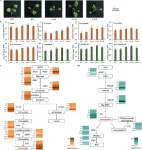(Press-News.org) Rachel L. Wasserman, PharmD, of the Department of General Internal Medicine at Brigham and Women’s Hospital, is the lead author and David W. Bates, MD, medical director of Clinical and Quality Analysis for Mass General Brigham and Co-Director of the Center for Artificial Intelligence and BioInformatics for Mass General Brigham, is the senior author of a new study published in BMJ Quality & Safety, “Frequency and preventability of adverse drug events in the outpatient setting.”
How would you summarize your study for a lay audience?
Many studies have analyzed adverse drug events (ADEs) in the inpatient setting, but limited data exist regarding ADEs in the outpatient setting. This study is the largest recent study regarding outpatient ADEs; patients included a large population treated at multiple sites including primary care, specialty care and emergency departments, over a one-year period .
What was the goal of your study?
The aim of this study was to determine the incidence, severity, and preventability of ADEs in the outpatient setting and identify potential prevention strategies.
What methods or approach did you use?
We conducted an analysis of ADEs identified in a retrospective electronic health records review of outpatient encounters in 2018 of 13 outpatient sites in Massachusetts that included 13,416 outpatient encounters in 3,323 patients. Triggers were identified in the medical record including medications, consultations, laboratory results, and others. If a trigger was detected, a further in-depth review was conducted by nurses and adjudicated by physicians to examine the relevant information in the medical record.
What did you find?
In all, 5% of patients or one in 20 experienced an ADE over the one-year period. We identified 198 ADEs among 170 patients, who had a mean age of 60. Most patients experienced one ADE (87%), 10% experienced two ADEs, and 3% experienced three or more ADEs. The most frequent drug classes resulting in ADEs were cardiovascular (25%), central nervous system (14%), and anti-infective agents (14%). Severity was ranked as significant in 85%, 14% were serious, 1% was life-threatening, and there were no fatal ADEs. Of the ADEs, 22% were classified as preventable and 78% were not preventable. We identified 246 potential prevention strategies, and 23% of ADEs had more than one prevention strategy possibility.
What are the implications?
Despite efforts to prioritize patient safety, medication-related harms are still frequent. These results underscore the need for further improvement in medication safety in the outpatient setting.
What are the next steps?
We assessed the preventability of ADEs and found that about 22% were preventable given what is known today; for both these and the remainder, we identified potential prevention strategies. The most desirable appeared to be AI-related future prevention possibilities. Additional studies are needed to develop new prevention approaches and then assess their impact.
Authorship:
In addition to Rachel L. Wasserman, PharmD and David W. Bates, MD, MSc additional authors include Heba H. Edrees, PharmD, Mary G. Amato, PharmD, MPH, Diane L. Seger, RPh, Michelle L. Frits, BA, Andrew Y. Hwang, PharmD, and Christine Iannaccone, MPH.
Paper cited:
Wasserman RL et al. “Frequency and preventability of adverse drug events in the outpatient setting.” BMJ Quality and Safety. DOI: 10. 1136/bmjqs- 2024-017098.
Funding:
Disclosures:
The authors declare that the research was conducted in the absence of any commercial or financial relationships that could be construed as a potential conflict of interest. Dr. Bates reports grants and personal fees from EarlySense, personal fees from CDI Negev, equity from ValeraHealth, equity from Clew, equity from MDClone, personal fees and equity from AESOP, personal fees and equity from Feelbetter, equity from Guided Clinical Solutions, and grants from IBM Watson Health, outside the submitted work. Dr. Bates has a patent pending (PHC-028564 US PCT), on intraoperative clinical decision support.
END
Research Spotlight: Researchers find that adverse drug events are frequent and many are preventable in the outpatient setting
2024-07-09
ELSE PRESS RELEASES FROM THIS DATE:
From genomes to gardens: introducing the HortGenome Search Engine for horticultural crops
2024-07-09
The HortGenome Search Engine (HSE) introduces a groundbreaking tool that transforms the exploration of horticultural crops' genetics. Enabling swift access and analysis of data from over 500 plant species, HSE enhances our ability to decode complex genetic networks. This launch marks a pivotal advancement in horticultural studies, offering detailed insights into crop genetics critical for human nutrition and health.
As genomics profoundly reshapes our understanding of horticultural crops, researchers often grapple with dispersed and complex genomic data. This fragmentation significantly hinders effective analysis ...
From winter's rest to spring's bloom: PmDAM6 gene steers plant bud dormancy
2024-07-09
This pivotal study explores the genetic orchestration of bud dormancy in woody perennials, a survival strategy crucial for enduring harsh climates. It focuses on the PmDAM6 gene, revealing its regulatory effects on lipid metabolism and phytohormone dynamics within dormant meristems, which dictate the plant's seasonal transition from rest to growth.
Plant dormancy's genetic mechanisms are vital for enhancing agricultural resilience and productivity. The interaction between lipid metabolism and hormone regulation significantly influences ...
From kale to carotenoid powerhouse: a breakthrough in plant nutrition
2024-07-09
A recent study has identified a crucial regulatory mechanism in Chinese kale, potentially revolutionizing its nutritional profile. By manipulating the BoaBZR1.1 transcription factor, researchers significantly enhanced carotenoid levels, crucial antioxidants for human health. This advancement opens pathways for improving vegetable nutrition through genetic engineering.
Carotenoids, vital antioxidants in plants, are integral for human health, enhancing immunity and preventing diseases. However, many vegetables, including Chinese kale, naturally exhibit low carotenoid levels. To address this nutritional gap, scientists are exploring genetic ...
CMU, Meta announce research collaboration aimed at making computer-based tasks and gaming accessible to people with different motor abilities via wearable sensing technology
2024-07-09
PITTSBURGH - As part of a larger commitment to developing equitable technology, Carnegie Mellon University and Meta announce a collaborative project to make computer-based tasks accessible to more people. This project focuses on using wearable sensing technology to enable people with different motor abilities to perform everyday tasks and enjoy gaming in digital and mixed reality environments.
Meta’s research in electromyography uses sensors placed on the skin to measure the electrical signals the user generates through muscles in their wrist, which are translated into input signals for various devices. While Meta has already ...
Detecting defects in tomorrow’s technology
2024-07-09
Silicon computer chips have served us well for more than half a century. The tiniest features on chips currently sold are approximately 3 nanometers — a startlingly small size given that a human hair is roughly 80,000 nanometers wide. Reducing the size of features on chips will help us meet our endless need for more memory and processing power in the palm of our hand. But the limit of what can be achieved with standard materials and processes is near.
Researchers at the U.S. Department of Energy’s (DOE) Princeton Plasma Physics Laboratory (PPPL) are applying their expertise in ...
It takes a cool microscope and antifreeze to really look at ice
2024-07-09
Ice in nature is surrounded by liquid most of the time, and therefore it is key to understand how ice and liquid interact. A Kobe University and Institute for Molecular Science study could now for the first time directly observe the precise shape of ice at the interface between ice and liquid – by using antifreeze and a refrigerated microscope.
When we slide on ice, when snowflakes form, when we lick ice cream, the surface of the ice is always covered with liquid water, and understanding the interaction between the ...
First local extinction in the US due to sea level rise
2024-07-09
The United States has lost its only stand of the massive Key Largo tree cactus in what researchers believe is the first local extinction of a species caused by sea level rise in the country.
The Key Largo tree cactus (Pilosocereus millspaughii) still grows on a few scattered islands in the Caribbean, including northern Cuba and parts of the Bahamas. In the United States, it was restricted to a single population in the Florida Keys, first discovered in 1992 and monitored intermittently since.
Salt water intrusion from rising seas, soil depletion from hurricanes and high tides, and herbivory by mammals had put significant pressure ...
Empowering Ugandan female youth with self-esteem, self-efficacy, and gratitude using Transcendental Meditation
2024-07-09
A peer-reviewed study published today in Health Care for Women International found that the Transcendental Meditation® (TM®) technique can empower the lives of female youth living under conditions of poverty in the city slums of Kampala, Uganda. Outcomes include increased self-esteem, self-efficacy, and gratitude; and decreased tiredness, worry, and excessive alcohol use. TM helped these young women improve their mental and physical health, as well as their relations with family and community members.
“The ...
Brian Wachtel is promoted to Chief Development Officer at NFCR
2024-07-09
The National Foundation for Cancer Research (NFCR) proudly announces the promotion of Brian Wachtel to Chief Development Officer. Brian will continue his responsibilities as the Executive Director, and his expanded role will further enhance his leadership within the organization.
Brian joined the National Foundation for Cancer Research in September 2016 as the Director of Corporate Partnerships & Special Events. In that capacity, he was in charge of organizing and expanding NFCR’s community outreach events. One of his important ...
Digital self-harm surges among U.S. teens from 2016 to 2021
2024-07-09
Adolescents worldwide have embraced social media and online platforms for self-expression and to explore their identity. This freedom, however, can lead to risky behaviors, especially with limited adult supervision. For example, digital self-harm is a recent, emerging trend where individuals anonymously post or share hurtful content about themselves online. This behavior can be mistaken for mistreatment by others, yet the perpetrator and victim are the same person.
First identified in 2010, digital self-harm has not received the same amount of scholarly scrutiny as other forms of self-directed abuse and has not been widely addressed by adults ...








